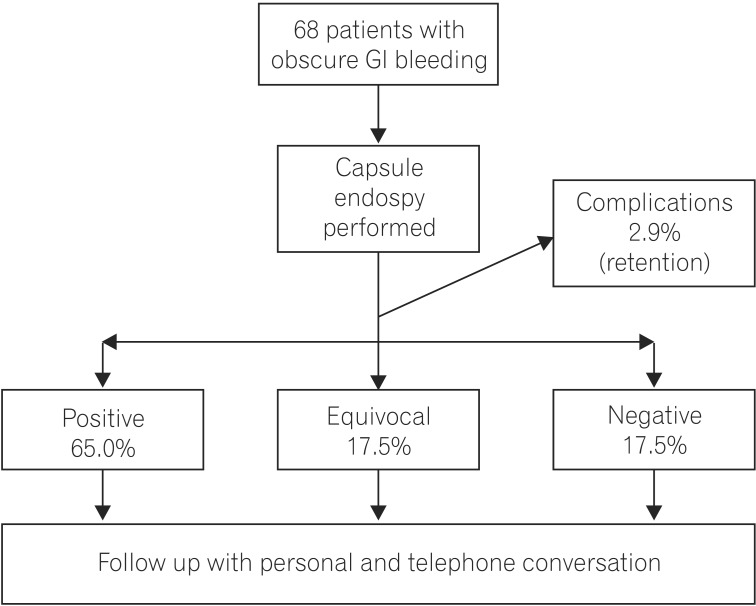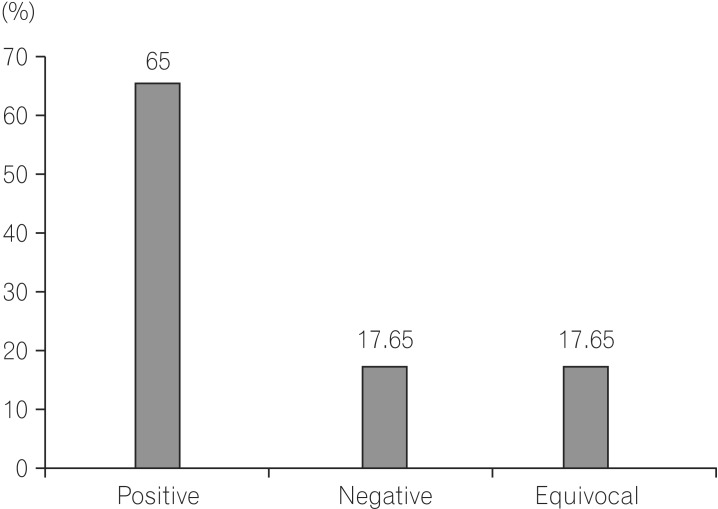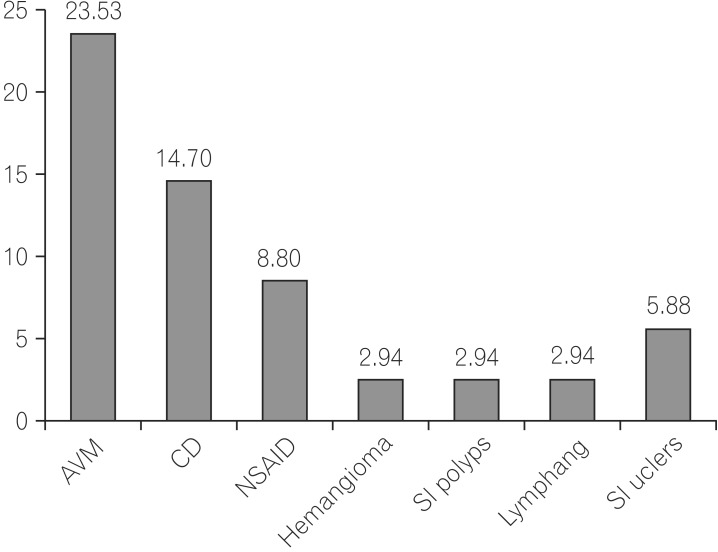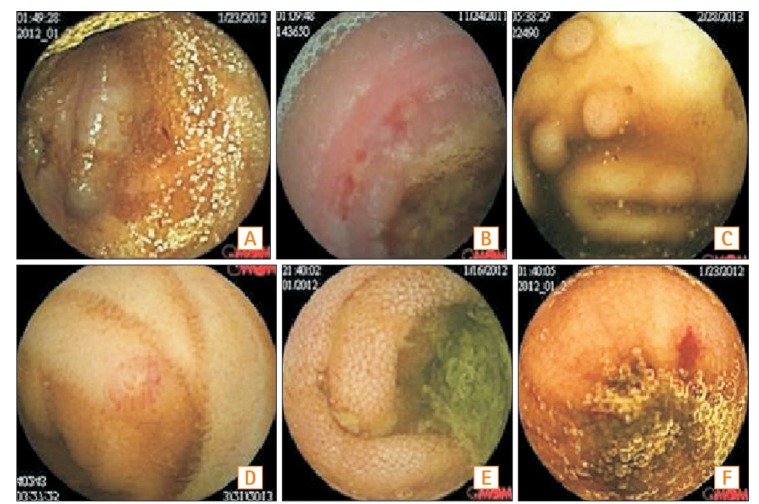Intest Res.
2016 Jan;14(1):69-74. 10.5217/ir.2016.14.1.69.
The role of capsule endoscopy in etiological diagnosis and management of obscure gastrointestinal bleeding
- Affiliations
-
- 1Department of Gastroenterology, Lokmanya Tilak Municipal Medical College & Lokmanya Tilak Municipal General Hospital, Mumbai, India. reenaupadhyay66@gmail.com
- KMID: 2174512
- DOI: http://doi.org/10.5217/ir.2016.14.1.69
Abstract
- BACKGROUND/AIMS
To investigate the various etiologies, yields, and effects of capsule endoscopy (CE) on management and complications, along with follow up of patients with obscure gastrointestinal (GI) bleeding.
METHODS
The study group of patients included those having obscure, overt, or occult GI bleeding. The findings were categorized as (A) obvious/definitive, (B) equivocal, or (C) negative. Any significant alteration in patient management post CE in the form of drug or surgical intervention was noted.
RESULTS
Total patients included in the study were 68 (48 males and 20 females). The ratio of male:female was 2.4:1. The age ranged between 16 years to 77 years. Mean age for males was 62+/-14 years, for females 58+/-16 years. The total yield of CE with definitive lesions was in 44/68 (65.0%) of patients. In descending order (A) angiodysplasia 16/68 (23.53%), (B) Crohn's disease 10/68 (14.70%), (C) non-steroidal anti-inflammatory drug enteropathy 8/68 (11.76%), (D) small bowel ulcers 4/68 (5.88%), (E) jejunal and ileal polyps 2/68 (2.94%), (F) intestinal lymphangiectasis 2/68 (2.94%), and (G) ileal hemangiomas 2/68 (2.94%) were followed. Equivocal findings 12/68 (17.65%) and negative study 12/68 (17.65%) was found. Complications in the form of capsule retention in the distal ileum were noted in 2/68 (2.94%) subjects. Statistically, there was a higher probability of finding the etiology if the CE was done during an episode of bleeding.
CONCLUSIONS
CE plays an important role in diagnosing etiologies of obscure GI bleeding. Its role in influencing the management outcome is vital.
MeSH Terms
Figure
Cited by 2 articles
-
The Role of Dynamic Contrast-enhanced Multidetector-row Computed Tomography in Diagnosis of Obscure Gastrointestinal Bleeding
Jee Hyun Kim, Jong Pil Im
Korean J Gastroenterol. 2016;67(4):165-167. doi: 10.4166/kjg.2016.67.4.165.Role of capsule endoscopy in suspected or established Crohn's disease in real practice
Hyun Joo Jang
Intest Res. 2017;15(4):431-433. doi: 10.5217/ir.2017.15.4.431.
Reference
-
1. Sidhu R, McAlindon ME, Kapur K, Hurlstone DP, Wheeldon MC, Sanders DS. Push enteroscopy in the era of capsule endoscopy. J Clin Gastroenterol. 2008; 42:54–58. PMID: 18097290.
Article2. May A, Nachbar L, Schneider M, Ell C. Prospective comparison of push enteroscopy and push-and-pull enteroscopy in patients with suspected small-bowel bleeding. Am J Gastroenterol. 2006; 101:2016–2024. PMID: 16968508.
Article3. Saurin JC, Delvaux M, Gaudin JL, et al. Diagnostic value of endoscopic capsule in patients with obscure digestive bleeding: blinded comparison with video push-enteroscopy. Endoscopy. 2003; 35:576–584. PMID: 12822092.
Article4. ASGE Standards of Practice Committee. Fisher L, Lee Krinsky M, et al. The role of endoscopy in the management of obscure GI bleeding. Gastrointest Endosc. 2010; 72:471–479. PMID: 20801285.
Article5. Teshima CW, Kuipers EJ, van Zanten SV, Mensink PB. Double balloon enteroscopy and capsule endoscopy for obscure gastrointestinal bleeding: an updated meta-analysis. J Gastroenterol Hepatol. 2011; 26:796–801. PMID: 21155884.
Article6. Gupta R, Lakhtakia S, Tandan M, et al. Capsule endoscopy in obscure gastrointestinal bleeding--an Indian experience. Indian J Gastroenterol. 2006; 25:188–190. PMID: 16974033.7. Pongprasobchai S, Chitsaeng S, Tanwandee T, Manatsathit S, Kachintorn U. Yield, etiologies and outcomes of capsule endoscopy in Thai patients with obscure gastrointestinal bleeding. World J Gastrointest Endosc. 2013; 5:122–127. PMID: 23515435.
Article8. Triester SL, Leighton JA, Leontiadis GI, et al. A meta-analysis of the yield of capsule endoscopy compared to other diagnostic modalities in patients with obscure gastrointestinal bleeding. Am J Gastroenterol. 2005; 100:2407–2418. PMID: 16279893.
Article9. Liao Z, Gao R, Xu C, Li ZS. Indications and detection, completion, and retention rates of small-bowel capsule endoscopy: a systematic review. Gastrointest Endosc. 2010; 71:280–286. PMID: 20152309.
Article10. Zhang BL, Chen CX, Li YM. Capsule endoscopy examination identifies different leading causes of obscure gastrointestinal bleeding in patients of different ages. Turk J Gastroenterol. 2012; 23:220–225. PMID: 22798110.
Article11. Koulaouzidis A, Rondonotti E, Giannakou A, Plevris JN. Diagnostic yield of small-bowel capsule endoscopy in patients with iron-deficiency anemia: a systematic review. Gastrointest Endosc. 2012; 76:983–992. PMID: 23078923.
Article12. Freeman HJ, Nimmo M. Intestinal lymphangiectasia in adults. World J Gastrointest Oncol. 2011; 3:19–23. PMID: 21364842.
Article13. Mohandas KM, Desai DC. Epidemiology of digestive tract cancers in India. V. Large and small bowel. Indian J Gastroenterol. 1999; 18:118–121. PMID: 10407566.14. Rao C, Sharma A, Rana SS, et al. Massive obscure overt gastrointestinal bleed: an unusual cause diagnosed by capsule endoscopy. J Postgrad Med Edu Res. 2012; 46:37–39.
Article15. Pennazio M, Santucci R, Rondonotti E, et al. Outcome of patients with obscure gastrointestinal bleeding after capsule endoscopy: report of 100 consecutive cases. Gastroenterology. 2004; 126:643–653. PMID: 14988816.
Article
- Full Text Links
- Actions
-
Cited
- CITED
-
- Close
- Share
- Similar articles
-
- Should Capsule Endoscopy Be the First Test for Every Obscure Gastrointestinal Bleeding?
- Hemorrhagic Small Bowel Tumor Diagnosed with Using Capsule Endoscopy and It was Treated with Laparoscopic Surgery: Report of a Case
- The Role of Endoscopy in Obscure Gastrointestinal Bleeding
- Diagnosis of Obscure Gastrointestinal Bleeding
- The Role of Capsule Endoscopy in Patients with Obscure Gastrointestinal Bleeding






